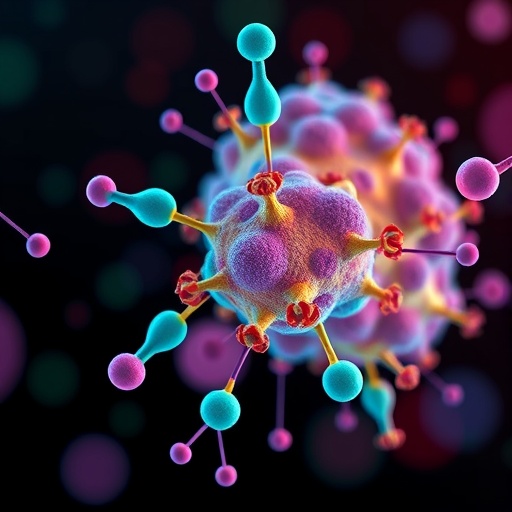In the ever-evolving landscape of cancer treatment, one of the most significant challenges remains the immunosuppressive tumor microenvironment (TME). Researchers are continuously seeking innovative approaches that can enhance the effectiveness of cancer therapies, particularly immunotherapy, which is heralded for its potential to harness the body’s immune system against malignancies. Recent advancements have pointed toward a groundbreaking synergy between ferroptosis, a form of regulated cell death, and immunotherapy, revealing a promising frontier in cancer treatment that could reshape therapeutic strategies significantly.
Ferroptosis is characterized by iron-dependent lipid peroxidation that leads to cell death. Unlike apoptosis, which is a well-known programmed cell death pathway, ferroptosis presents a different biochemical mechanism that can be employed to tackle tumor cells effectively. Researchers at Chengdu University, led by Dr. Xiao Wei and Dr. Mingzhu Song, conducted an extensive review that integrates these two formidable treatment modalities. Their findings present a systematic roadmap for combining ferroptosis with immunotherapy, a strategy that not only aims to induce cancer cell death but also to remodel the tumor microenvironment to promote immune responses.
One of the most compelling reasons for focusing on the synergistic potential of ferroptosis and immunotherapy is the concept of immunogenic cell death (ICD). This process not only facilitates the demise of tumor cells but also stimulates the immune system. When tumor cells undergo ferroptosis, they release damage-associated molecular patterns (DAMPs) that can activate various components of the immune system, including dendritic cells and T cells. This activation is crucial in fostering a robust anti-tumor immune response, paving the way for more effective cancer treatments.
The implications of ferroptosis go beyond mere cell death; they extend to the realm of TME reprogramming. Conventional tumors often exhibit immunosuppressive features that hinder the infiltration of immune cells, rendering immunotherapy less effective. Interestingly, ferroptosis has been shown to disrupt these immunosuppressive niches and enhance immune cell infiltration, effectively transforming so-called “cold” tumors into “hot” tumors that are more amenable to immunotherapeutic strategies. This transformation is vital for improving the overall efficacy of cancer treatment protocols.
Moreover, the integration of ferroptosis and immunotherapy holds promise for eliciting systemic immunity. The combined approach can not only inhibit primary tumor growth but also prevent metastatic spread, resulting in long-term immune memory that helps the body combat potential tumor recurrences. This ability to consolidate an immune memory offers a significant advantage and warrants increased attention from researchers and oncologists alike.
To effectively harness this synergy, the development of innovative nanoplatforms becomes essential. These interdisciplinary platforms are not just vehicles for drug delivery but multifunctional systems designed to overcome the numerous challenges posed by the TME. The recent review emphasizes advanced design principles, such as material selection, structural configuration, and physicochemical modulation, which are critical in creating effective nanoplatforms. These platforms enhance drug efficacy while ensuring targeted delivery, minimizing off-target effects that can lead to toxicity.
Stimuli-responsive drug release systems constitute a cornerstone of the innovative approaches being explored. By utilizing external triggers such as pH changes, redox conditions, and enzymatic activities, these nanoplatforms can achieve precise activation of therapeutic agents right within the tumor environment. This specificity not only maximizes the efficacy of treatment but also reduces systemic side effects, an essential consideration in oncology.
Furthermore, the integration of imaging capabilities into these nanoplatforms allows for real-time monitoring of therapeutic responses. Techniques such as MRI, fluorescence, photoacoustic imaging, and ultrasound can provide valuable insights into treatment efficacy, enabling timely adjustments to therapy as needed. This holistic approach could significantly enhance personalized treatment strategies, ensuring that patients receive the most effective interventions tailored to their specific tumor biology.
The applications of these synergistic ferroptosis-immunotherapy strategies are far-reaching. For instance, direct immune amplification can be achieved through engineered nanoplatforms that enhance immunogenicity, activate pathways like cGAS-STING signaling, and deliver immune adjuvants. By improving the immunogenicity of tumors, patients may experience enhanced responses to immunotherapy, marking a significant step forward in cancer treatment outcomes.
Moreover, disrupting immunosuppressive niches is another vital application where the combination of ferroptosis with immune checkpoint blockade (ICB) agents, such as anti-PD-1/PD-L1 or anti-CTLA-4 therapies, can reverse the immunosuppressive state of the TME. This combination could lead to a potent re-engagement of the immune system, further enhancing anti-tumor effects and improving survival rates.
As clinical experiments progress, the translational potential of ferroptosis-immunotherapy nanoplatforms appears promising. The utilization of FDA-approved drugs, like sorafenib and artesunate, as well as novel nanomedicines such as mRNA vaccines and TLR agonists, is setting the stage for real-world applications. Early-phase clinical trials are positioning these innovative combination strategies for broader testing, underscoring the need for continued research and development.
The future outlook for the field remains exceedingly optimistic. By fostering interdisciplinary collaboration among materials science, immunology, and oncology, researchers aim to expedite the real-world translation of these findings into meaningful therapies that can improve patient outcomes in a very different way than traditional treatments have managed thus far.
In conclusion, the synergy between ferroptosis and immunotherapy offers a transformative potential in cancer treatment paradigms. The ongoing research elucidates novel pathways to overcome the inherent challenges posed by the tumor microenvironment, delivering hope for enhanced therapeutic strategies that could revolutionize cancer care. Stay attuned for groundbreaking studies emerging from the laboratories of Dr. Xiao Wei and Dr. Mingzhu Song, as the impacts of this innovative synergy continue to unfold.
Subject of Research: Synergistic Ferroptosis–Immunotherapy Nanoplatforms
Article Title: Synergistic Ferroptosis–Immunotherapy Nanoplatforms: Multidimensional Engineering for Tumor Microenvironment Remodeling and Therapeutic Optimization
News Publication Date: 2-Sep-2025
Web References: 10.1007/s40820-025-01862-6
References: N/A
Image Credits: Xiao Wei, Yanqiu Jiang, Feiyang Chenwu, Zhi Li, Jie Wan, Zhengxi Li, Lele Zhang, Jing Wang, Mingzhu Song
Keywords
Immunotherapy, Ferroptosis, Nanoplatforms, Cancer Treatment, Tumor Microenvironment, Immune Response, Drug Delivery Systems, Systemic Immunity, Immunogenic Cell Death, Interdisciplinary Collaboration, Therapeutic Optimization.
Tags: advanced cancer treatment modalitiescancer treatment innovationsChengdu University cancer researchenhancing treatment efficacy in cancerferroptosis and immunotherapy synergyimmune system activation in tumorsimmunogenic cell death techniqueslipid peroxidation in cancer therapynovel therapeutic strategies for malignanciesovercoming immunosuppressive tumor environmentsregulated cell death mechanismstumor microenvironment transformation





